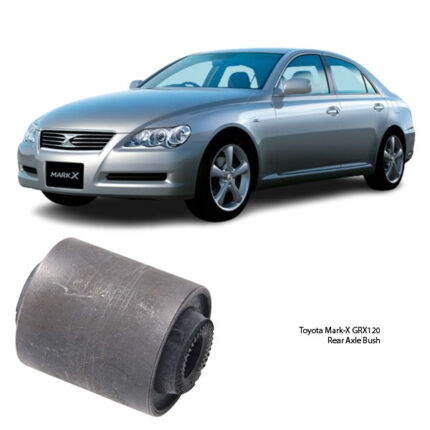-25%
Get Mitsubishi Pajero/Montero Shogun Rear Axle Rod Arm Bush
The rear axle rod arm bush, also known as the rear trailing arm bush or rear control arm bushing, is a component of a vehicle’s suspension system. It plays a crucial role in connecting the rear axle or rear suspension assembly to the vehicle’s chassis. The bushing is typically made of rubber or polyurethane and is mounted between the rear axle rod arm and the vehicle’s frame or body.
Function:
The primary function of the rear axle rod arm bush is to provide cushioning, flexibility, and support to the rear axle or suspension assembly. It absorbs and dampens road shocks and vibrations, helping to improve ride comfort, stability, and handling. The bushing allows for controlled movement of the rear axle or suspension components while minimizing noise, harshness, and vibration transmitted to the vehicle’s occupants.
Benefits;
1. Stability and Control:
- Maintains Wheel Alignment: The rear axle rod arm bushings help maintain proper wheel alignment by securing the rear axle in its correct position relative to the chassis. This ensures consistent handling and stability, especially during cornering and maneuvering.
2. Smooth Ride Quality:
- Absorbs Road Vibrations: Rear axle rod arm bushings help absorb and dampen road vibrations and impacts, reducing the transmission of bumps and shocks to the vehicle’s chassis and occupants. This contributes to a smoother and more comfortable ride quality.
3. Improved Handling:
- Enhances Cornering Stability: By providing a stable connection between the rear axle and the chassis, the bushings enhance cornering stability and control. This results in more predictable handling and reduced body roll during turns.
4. Reduced Noise and Vibration:
- Minimizes Noise Transmission: Rear axle rod arm bushings help isolate the rear axle from the chassis, reducing the transmission of noise, vibration, and harshness (NVH) to the vehicle’s cabin. This leads to a quieter and more refined driving experience.
5. Longevity and Durability:
- Enhances Component Longevity: Properly functioning rear axle rod arm bushings help distribute forces and stresses evenly across the suspension system, reducing wear and tear on other components. This contributes to the longevity and durability of the suspension system as a whole.
6. Improved Traction:
- Optimizes Tire Contact Patch: By maintaining proper wheel alignment and suspension geometry, rear axle rod arm bushings help optimize the contact patch of the rear tires with the road surface. This enhances traction and grip, especially during acceleration and cornering.
7. Enhanced Safety:
- Ensures Proper Suspension Function: Rear axle rod arm bushings play a critical role in ensuring the proper function of the rear suspension system. By providing stability and control, they contribute to overall vehicle safety, particularly during dynamic driving situations.
Signs a car needs a new one;
1. Excessive Noise:
- Clunking or Banging: Worn or damaged rear axle rod arm bushings can cause clunking or banging noises, especially when driving over bumps or rough roads. This occurs due to excessive play or movement in the bushings.
2. Increased Vibrations:
- Vibration in the Rear: Excessive vibrations felt in the rear of the vehicle, especially during acceleration or braking, can indicate worn rear axle rod arm bushings. These vibrations may feel more pronounced in the seats or floorboards.
3. Handling Issues:
- Loose or Unstable Handling: Worn or damaged rear axle rod arm bushings can affect vehicle stability and handling, particularly during cornering or sudden maneuvers. The vehicle may feel less responsive and more prone to swaying or drifting.
4. Uneven Tire Wear:
- Inner or Outer Tire Wear: Worn or damaged rear axle rod arm bushings can lead to uneven tire wear, particularly on the rear tires. Look for signs of excessive wear on the inner or outer edges of the tire tread.
5. Visual Inspection:
- Visible Damage or Wear: Inspect the rear axle rod arm bushings visually for signs of damage, such as cracking, tearing, or deterioration. Pay close attention to the condition of the rubber or polyurethane material surrounding the bushings.
- Leaking Fluid: Some rear axle rod arm bushings are filled with hydraulic fluid or lubricant. If you notice fluid leaking from the bushings or signs of fluid seepage, it may indicate a failure of the bushings.
6. Suspension Sag or Sagging Ride Height:
- Uneven Ride Height: A noticeable sagging or uneven ride height in the rear of the vehicle, especially on one side, may indicate a problem with the rear axle rod arm bushings. This occurs as the bushings lose their ability to support the weight of the vehicle.
Follow us on Facebook for more parts.



